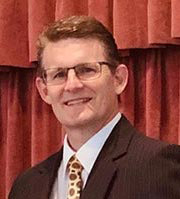Fresh perspective, willingness to change are among the keys to church revitalization
By David Dawson
Baptist and Reflector
ddawson@tnbaptist.org
 FRANKLIN — Although Kevin Minchey appreciates the importance of numbers, he believes church revitalization can sometimes be as much about attitude as attendance.
FRANKLIN — Although Kevin Minchey appreciates the importance of numbers, he believes church revitalization can sometimes be as much about attitude as attendance.
Appearing as a guest on a recent B&R Radio podcast, Minchey, the church revitalization team leader for the Tennessee Baptist Mission Board, said that some churches can start the revitalization process by making adjustments in the areas in which they have “backslidden in their enthusiasm.” (The full podcast, Episode 44, here).
Minchey, who has been in his current role with the TBMB since December, noted that revitalization and revival share the same root word, and are closely linked in their purpose.
“We get revived from a revival,” he said. “When you say revival in Southern Baptist life, people think about a series of meetings. But actually, the objective is the same (for both revival and revitalization) — the need for a fresh stirring of the Holy Spirit and His power.”

Kevin Minchey
In his first six months with the TBMB, Minchey has worked with churches of all sizes, and each church has its own story to tell in regard to how it became in need of revitalization. But the end goal is the same in every case — helping these churches find, or relocate, the formulas that allow them to connect with their communities and make an impact for the Lord.
“When we talk about revitalization, we’re talking about getting back to a place of spiritual productivity and fruitfulness,” he said.
The church revitalization process generally begins with an overall church assessment, which enables churches to examine their numbers from the past several years and gain a general idea of the effectiveness of their current ministries.
If the number of people being saved and baptized has been steadily declining from one year to the next, “it’s an indicator” of the direction of the church, Minchey said.
“If less people are showing up for worship, less people are in Bible study, less people are giving, less people are getting saved and baptized, then that’s probably a good time to have a church revitalization discussion,” he said.
Church revitalization isn’t just for churches who are in danger of closing their doors, however. Minchey noted that, in some instances, churches who might be labeled as “healthy” could still need to make some adjustments. “(There are) times when churches are doing really well year after year after year, but they want to go to the next level and they’ve just become complacent,” he said. “One of our (TBC) churches was baptizing a good number of people every year, but they made a decision to try to double their baptisms this past year — and they were able to do that.”
Minchey said that this particular church was already among the leading churches in Tennessee in terms of baptisms, but they were determined not to rest on that.
“So, that was a form of revitalization,” he noted, because the church members were willing to ask themselves: “What could we do if we really got serious about seeking God and seeking lost people? (And now they’ve had) twice as many people getting saved for two years in a row.”
![]() Minchey noted the revitalization process can be “tricky” for churches who do not — on the surface — seem to be in need of it. He said, in many cases, the term “healthy” is just a way of saying that a church is stable. But there is actually a difference between the two, he said.
Minchey noted the revitalization process can be “tricky” for churches who do not — on the surface — seem to be in need of it. He said, in many cases, the term “healthy” is just a way of saying that a church is stable. But there is actually a difference between the two, he said.
“(Stable) means we’re not fighting, we’re paying our bills, we’re not losing a lot of ground,” he said, “but that doesn’t (necessarily) mean they are healthy.”
Minchey said if the population around the church is growing, but the church’s numbers are staying the same over a five-year period, then it might be time to consider revitalization.
Minchey said some churches might be in a situation where “it feels, from the inside, like, hey, we’re healthy, we’re doing well,” but in reality, the church is not reaching its potential.
In those instances, Minchey said the conversations can be challenging because the church leaders might not even realize, or admit, they could use some help. In those situations, Minchey said he and his team would “gently and pastorally argue that a healthy church is gaining new ground for the kingdom every year,” said Minchey.
Minchey said the COVID-19 pandemic has created the need for many churches to take a hard look at their situations and determine what steps they need to take in order to reach their potential.
“I think the reset that happened (during the period in which most churches were not meeting) has been an asset,” he said. “It wasn’t just an interruption. I think it gave pastors a break where they could breathe, and they could step back. They could look at their situation.”
Minchey said the pandemic presented churches with the opportunity to really find out what they are all about.
“I think one good thing that came out of it is that it showed us — like we’ve always said — that the church is not the building,” he said. “We now know that’s true because we kept on going. We kept praying. We kept staying in contact.”
As with many challenging issues in life, the starting point in revitalization is often for the church to admit that it needs help. Minchey said this is often the “first barrier.”
“The reason why it’s a barrier … is that it feels like it is admitting defeat, or saying ‘our church is lacking’,” Minchey said. “It’s a self-judgment call.”
Another barrier in the process, Minchey noted, is that some churches are reluctant to change their approach. But in many cases, true revitalization cannot take place without changes being made. The entire process hinges on that, Minchey said.
He noted that this requires more than “just changing the worship style or adding another Sunday School class.”
“Sometimes we have to break apart some fallow ground,” he said, citing examples such as church leaders not getting along or deacons who are not communicating. “So, the church is not going to go to the next level because everybody knows that stuff is going on, or they have tolerated some things they shouldn’t have tolerated.”
In those cases, Minchey said, the church “doesn’t have a real solid center” and has lost its focus on reaching people for Jesus.
“If we’ve departed from that, we’ve got to come back to it, and that’s very painful,” he said. “It’s easier just to say, well, we’re going to keep going like we are.”
Minchey said many churches do recognize that they are in need of a boost. And in many cases, the members are willing to roll up their sleeves and put forth an effort to get the church back on its feet. But even then, the road can still be rocky.
“The pastor wants to see the church do better, and the church wants to see the church do better to reach people,” said Minchy. “So, all these factors would indicate that, hey, it’s a no-brainer that we’re going to be able to just take this church to the next level — but that doesn’t always happen,” Minchey said.
“That’s when we come in and we say, well, let’s help you assess your church and find out … why are we not making any progress for the kingdom? Why are not more people’s lives being changed and souls being saved? That’s really the bottom line.”
